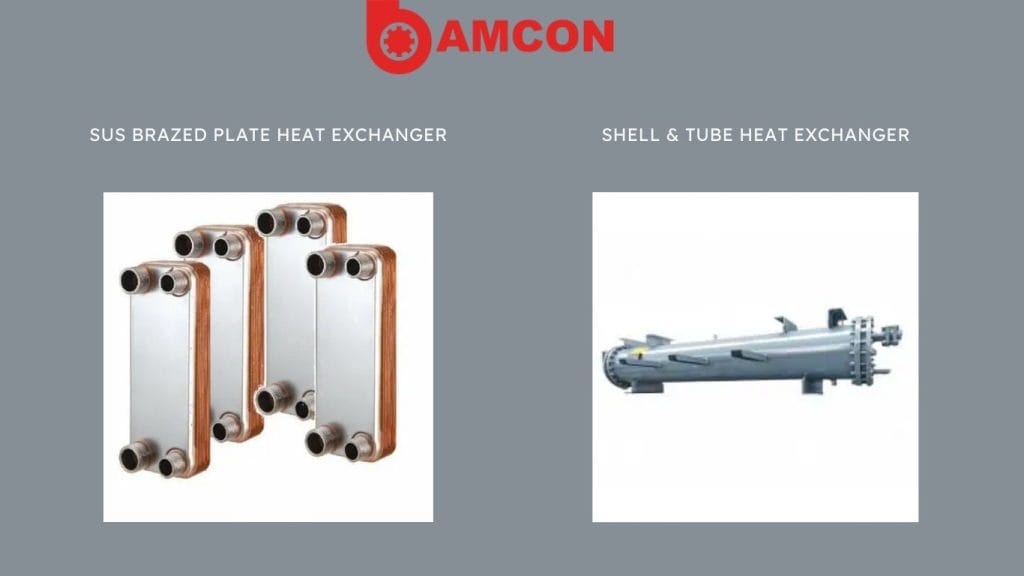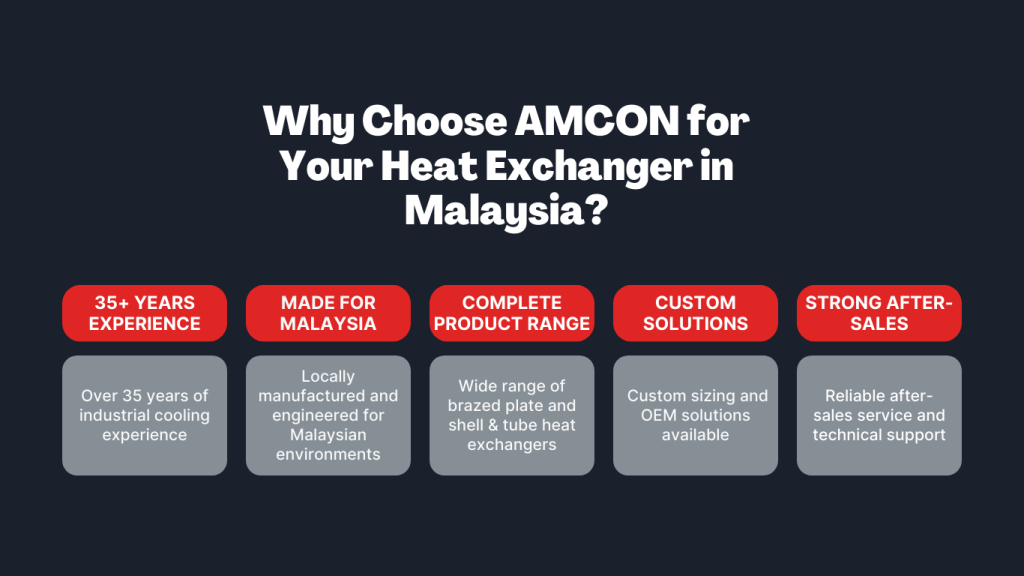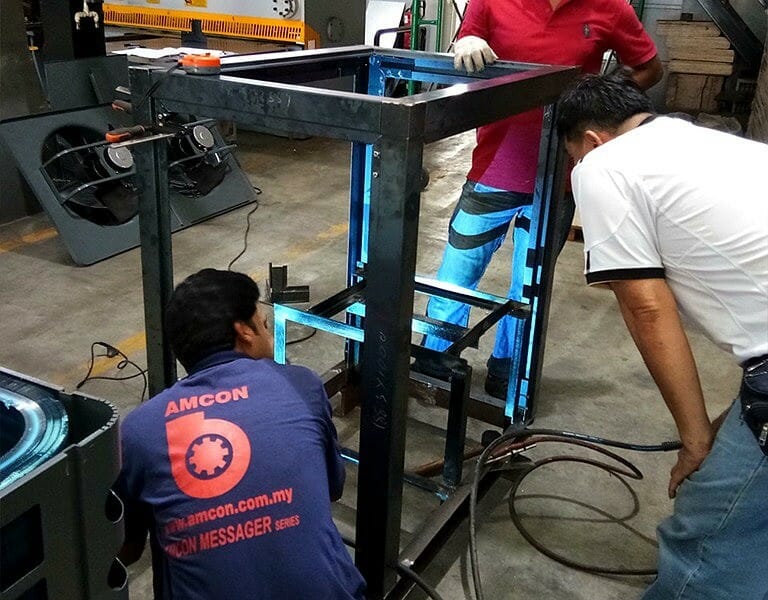Heat Exchangers in Malaysia: Types, Applications, and How to Choose
Heat Exchangers in Malaysia
Industrial cooling systems rely on efficient heat transfer — and that’s where heat exchangers play a critical role. From HVAC units to process chillers, a reliable heat exchanger Malaysia solution helps businesses improve energy efficiency, protect equipment, and maintain uninterrupted operations. As a leading manufacturer and supplier of cooling solutions in Malaysia, AMCON offers both brazed plate heat exchangers and shell & tube heat exchangers to serve different industrial needs. But which one is right for you?
This guide breaks down everything you need to know about heat exchangers — including types, use cases, and how to choose the right model for your system.
What Is a Heat Exchanger?
A heat exchanger is a device that transfers heat from one fluid to another — without the fluids actually mixing. In industrial settings, heat exchangers are commonly used in chillers, refrigeration systems, oil cooling processes, chemical plants, and air conditioning systems to maintain stable temperatures and improve operating efficiency.
Types of Heat Exchangers Offered by AMCON

1. Brazed Plate Heat Exchanger (BPHE)
A brazed plate heat exchanger consists of multiple thin metal plates that are brazed together in a compact block. Fluids flow in alternating channels between plates for maximum heat transfer.
Key advantages:
- Highly compact and lightweight
- Excellent thermal efficiency
- Low refrigerant charge
- Ideal for limited-space installations
Best suited for:
HVAC chillers, refrigeration, heat pumps, data centre cooling, packaged systems.
2. Shell & Tube Heat Exchanger
This traditional heat exchanger design features a bundle of tubes enclosed in a cylindrical shell. One fluid runs inside the tubes while the other passes around them within the shell.
Key advantages:
- Rugged and durable for high pressures/temperatures
- Easy to clean and maintain
- Long service life in harsh environments
Best suited for:
Chemical processing, oil & gas, marine, heavy-duty industrial applications.
Industrial Applications of Heat Exchangers in Malaysia
- HVAC systems (industrial chillers, air conditioners)
- Food & beverage processing
- Pharmaceutical and chemical plants
- Petrochemical and oil refineries
- Manufacturing cooling systems
- Energy recovery systems
With Malaysia’s warm climate and rapidly expanding industrial sector, choosing the right heat exchanger Malaysia solution is essential to control energy usage and protect mission-critical equipment.
How to Choose the Right Heat Exchanger for Your System
✔ Required Cooling Capacity
Choose a model that matches your system’s heat load (kW or tons). Undersized units risk overheating, while oversized units lead to inefficiency.
✔ Space Availability
Compact brazed plate heat exchangers are better suited for installations with tight space constraints. Shell & tubedesigns require more room but offer scalability.
✔ Operating Temperature & Pressure
High-pressure and high-temperature applications (e.g., oil cooling) are better served by shell & tube designs. Moderate conditions with cleaner fluids are ideal for brazed plate units.
✔ Fluid Type & Cleanliness
Dirty or viscous fluids (e.g., oil, process wastewater) need easy-to-clean designs like shell & tube. Clean fluids (e.g., refrigerants, water) are suitable for brazed plate units.
✔ Ease of Maintenance
If frequent cleaning or inspection is expected, a shell & tube heat exchanger’s removable covers simplify maintenance. Brazed plate models require less maintenance but may need pad cleaning if fouling occurs.
✔ Cost vs Performance
Brazed plate heat exchangers are cost-efficient and offer high thermal performance, while shell & tube exchangers have higher upfront costs but longer lifespans and better durability.

Whether you’re upgrading your industrial chiller, installing a HVAC system, or improving process cooling, choosing the right heat exchanger Malaysia solution is essential for long-term performance and efficiency. Brazed plate heat exchangers are compact and efficient, while shell & tube designs offer durability and easy servicing in harsh conditions.Need help selecting the perfect model?
Get in touch with AMCON — Malaysia’s trusted one-stop specialist for industrial heat exchangers and cooling systems.
FAQs about Heat Exchangers in Malaysia
In industrial HVAC and cooling applications, brazed plate heat exchangers are widely used due to their compact size and high thermal efficiency. However, shell & tube heat exchangers remain popular in heavy-duty industries like oil & gas and chemical processing.
With proper maintenance, industrial heat exchangers can last anywhere from 10 to 20 years, depending on factors such as operating conditions, fluid quality, and cleaning schedule.
Shell & tube units are larger, rugged, and suited for high pressure/temperature systems, while brazed plate exchangers are more compact, efficient, and typically used for clean fluid or closed-loop applications.
Sizing depends on your required heat transfer rate (kW), fluid flow rate, inlet/outlet temperatures, and operating pressures. It’s best to consult with a heat exchanger supplier like AMCON for proper selection
Yes — AMCON provides custom-designed brazed plate and shell & tube heat exchangers tailored to meet specific industrial requirements, along with local technical support and after-sales service.

